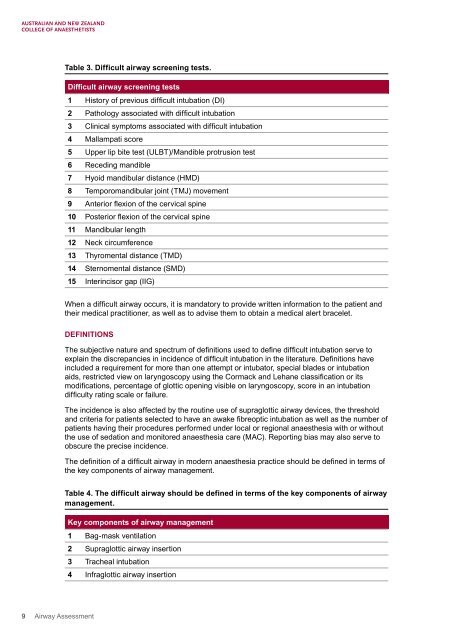Airway Assessment
2cKbSEQ
2cKbSEQ
You also want an ePaper? Increase the reach of your titles
YUMPU automatically turns print PDFs into web optimized ePapers that Google loves.
Table 3. Difficult airway screening tests.<br />
Difficult airway screening tests<br />
1 History of previous difficult intubation (DI)<br />
2 Pathology associated with difficult intubation<br />
3 Clinical symptoms associated with difficult intubation<br />
4 Mallampati score<br />
5 Upper lip bite test (ULBT)/Mandible protrusion test<br />
6 Receding mandible<br />
7 Hyoid mandibular distance (HMD)<br />
8 Temporomandibular joint (TMJ) movement<br />
9 Anterior flexion of the cervical spine<br />
10 Posterior flexion of the cervical spine<br />
11 Mandibular length<br />
12 Neck circumference<br />
13 Thyromental distance (TMD)<br />
14 Sternomental distance (SMD)<br />
15 Interincisor gap (IIG)<br />
When a difficult airway occurs, it is mandatory to provide written information to the patient and<br />
their medical practitioner, as well as to advise them to obtain a medical alert bracelet.<br />
DEFINITIONS<br />
The subjective nature and spectrum of definitions used to define difficult intubation serve to<br />
explain the discrepancies in incidence of difficult intubation in the literature. Definitions have<br />
included a requirement for more than one attempt or intubator, special blades or intubation<br />
aids, restricted view on laryngoscopy using the Cormack and Lehane classification or its<br />
modifications, percentage of glottic opening visible on laryngoscopy, score in an intubation<br />
difficulty rating scale or failure.<br />
The incidence is also affected by the routine use of supraglottic airway devices, the threshold<br />
and criteria for patients selected to have an awake fibreoptic intubation as well as the number of<br />
patients having their procedures performed under local or regional anaesthesia with or without<br />
the use of sedation and monitored anaesthesia care (MAC). Reporting bias may also serve to<br />
obscure the precise incidence.<br />
The definition of a difficult airway in modern anaesthesia practice should be defined in terms of<br />
the key components of airway management.<br />
Table 4. The difficult airway should be defined in terms of the key components of airway<br />
management.<br />
Key components of airway management<br />
1 Bag-mask ventilation<br />
2 Supraglottic airway insertion<br />
3 Tracheal intubation<br />
4 Infraglottic airway insertion<br />
9 <strong>Airway</strong> <strong>Assessment</strong>


